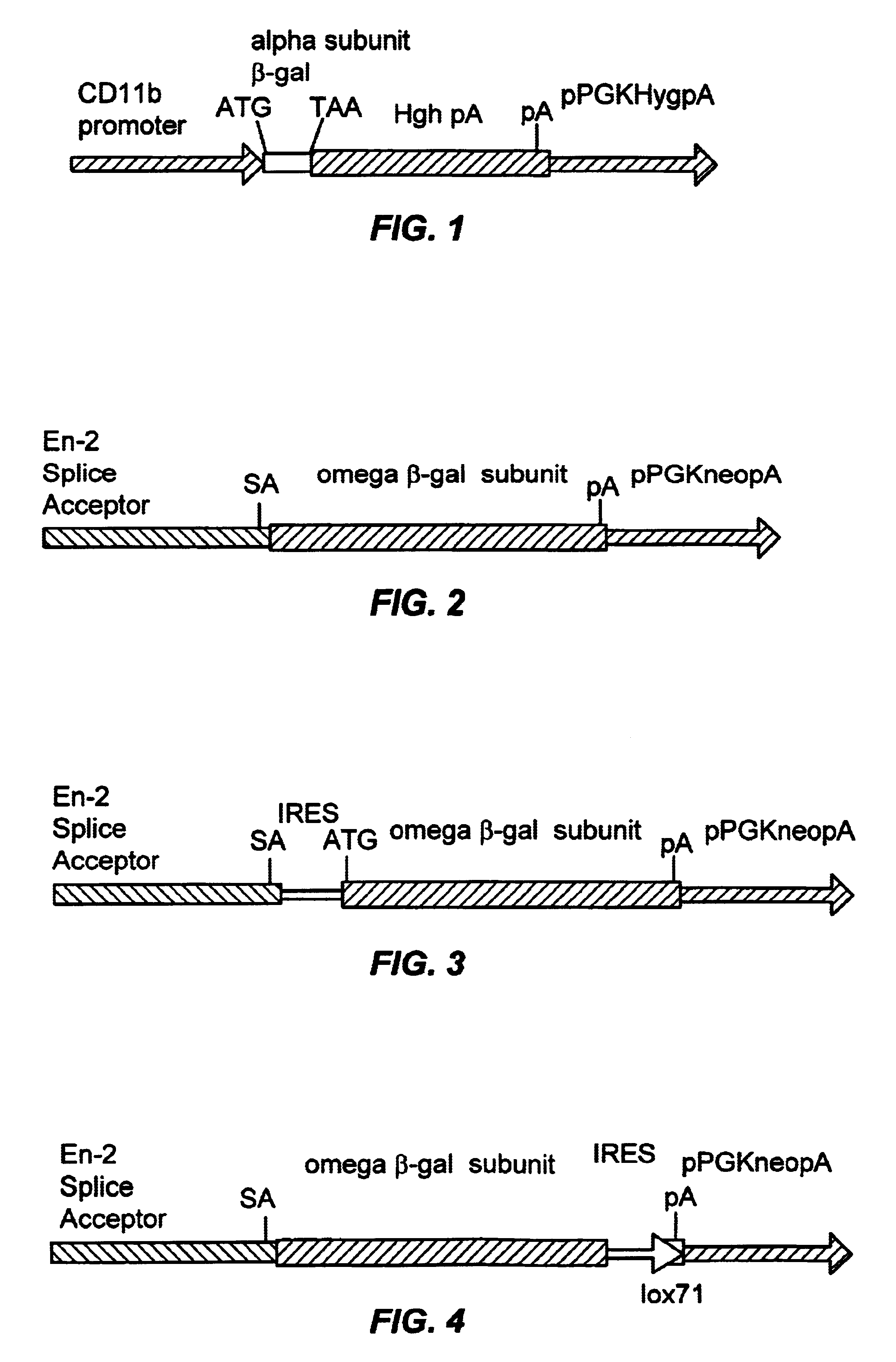Complementation trap
a technology of complementation traps and traps, applied in the field of complementation traps, can solve the problems of needing to establish a transgenic animal line, large-scale classical genetic mutational analysis using the mouse, and high cost and cumbersome random mutation screening and analysis
- Summary
- Abstract
- Description
- Claims
- Application Information
AI Technical Summary
Benefits of technology
Problems solved by technology
Method used
Image
Examples
example 1
Complementation trap vectors may be developed based on the alpha complementation of .beta.-galactosidase.
Vectors
FIG. 1 illustrates a CD11b alpha vector. The alpha subunit of beta-galactosidase is obtained by polymerase chain reaction (PCR) amplification using the following oligos from the pCMV .beta.-galactosidase plasmid: oligo 1 corresponds to the polylinker sequence 5' of .beta.-gal (.sup.5' AACTGCAGTACCCGCGGCCGC.sup.3' SEQ ID NO: 1) and the oligo 2 introduces stop codons at a position corresponding to amino acid 85 of the E.coli lacZ sequence: (.sup.5' AACTGCAGTTATTACTCAGGAAGATCGCACTCCAGC.sup.3' SEQ ID NO: 2). The PCR fragment is subcloned into pBluescript.TM.. The alpha subunit is then subcloned into the Bam HI site of the CD11b expression cassette containing the CD11b promoter and the human growth hormone mini gene and polyadenylation signal described in; Dzienni, S., et al. (1995) The CD11b Promoter Directs High-Level Expression of Resorter Genes in Macrophages in Transgenic ...
example 2
Transcriptional Activation (Two Hybrid System)
The two hybrid system is based on the fact that many eucaryotic transcriptional activators are comprised of two physically and functionally separable domains, a DNA-binding domain (DNA-BP) and an activation domain (AD). The two domains are normally part of the same protein. However, the two domains can be separated and expressed as distinct proteins. Two additional proteins (X and Y) are expressed as fusions to the DNA-BP and AD peptides. If X and Y interact, the AD is co-localized to the DNA-BP bound to the promoter, resulting in the transcription of the reporter gene.
The following is an example of the two hybrid transcriptional activation gene trap system. This system is composed of two fusion proteins, one component of which is expressed by a tissue- or cell- specific promoter and the second is found in a gene trap vector:
1) a fusion of protein X with the GAL4 DNA-BP;
2) a fusion of protein Y with the VP16 activation;
where protein X an...
example 3
Transcriptional Activation (Genetic Recombination Dependent)
This system makes use of a vector containing a stuffer DNA fragment flanked by lox sites preceding a reporter gene similar to that described by Lasko, et al., (1992): Targeted Oncogene Activation by Site-Specific Recombination in Transgenic Mice; Proc. Natl. Acad. Sci. USA 89:6232-6236. The expression of the reporter gene is dependent on the removal of the stuffer DNA sequence mediated by the Cre recombinase enzyme through site directed recombination of lox sites found flanking the stuffer DNA. The gene trap vector contains the Cre gene preceded by a splice acceptor sequence and an IRES. The gene trap vector may also contain a selectable marker.
PUM
 Login to View More
Login to View More Abstract
Description
Claims
Application Information
 Login to View More
Login to View More - R&D
- Intellectual Property
- Life Sciences
- Materials
- Tech Scout
- Unparalleled Data Quality
- Higher Quality Content
- 60% Fewer Hallucinations
Browse by: Latest US Patents, China's latest patents, Technical Efficacy Thesaurus, Application Domain, Technology Topic, Popular Technical Reports.
© 2025 PatSnap. All rights reserved.Legal|Privacy policy|Modern Slavery Act Transparency Statement|Sitemap|About US| Contact US: help@patsnap.com

